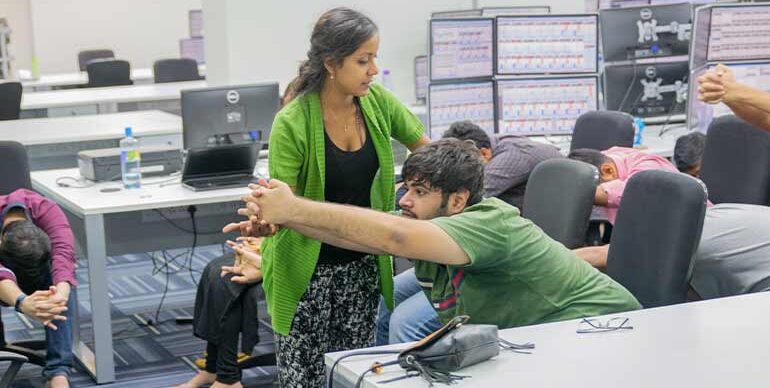
A workplace or an office is a location, where people from different localities and backgrounds come together to perform tasks, jobs and projects for their employers and settle into a routine interacting with one another on a daily basis. While this gives rise to a feeling of camaraderie and a sense of belonging, it also inevitably becomes a place where people share germs, spread diseases and ignore their chronic health issues.
Let us guide you on making your workplace, a place that actively promotes basic disease prevention and early detection, creating a multitude of health benefits for your company.
How does Early Detection Aid in Keeping Workers Healthy?
One of the targets of an employee wellness program is to help your employees avoid diseases altogether, through better nutrition, exercise and guidance on a healthy lifestyle. The earlier they are screened and examined for certain diseases the better the odds that the disease can be cured, prevented or successfully managed. For example, colorectal cancer and breast cancer if detected early have much higher chances of being cured. Having regular mammograms and colorectal cancer screenings, significantly reduces the mortality rate among employees.
How do Common Illnesses Impact the Workplace?
Most people worry about major chronic diseases such as cancer, but the reality is that the cold is the most common infectious disease, resulting in the majority of workplace absences. One does not need statistics to be convinced of the way COVID 19 has impacted the world. In today’s time if anyone simply sneezes, it’s not uncommon for a colleague to look suspiciously at them wondering how contagious they are, and why they didn’t stay put at home. No matter how careful everyone is at the workplace, you can’t keep every single germ at bay, so we will give you some tips on how you as an employer, can help in the context of your wellness program.
How to Help Employees Stay Well?
Your company’s wellness program should reaffirm for people, that their newfound healthy behaviours are genuinely helping them, even if they can’t see it. As part of this commitment to being healthy, it helps to get your employees accustomed to having regular screenings for cancer and other diseases.

The Impact of Education: You Really Can Prevent Disease
For many people, fear of an illness or diseases creates a mind block and they refrain from researching on it until they get a scary test result or diagnosis. A good wellness program can combat the tendency towards denial, by providing positive messages about the pronounced impact that good health behaviours and early detection can have on disease avoidance. Here are some ways to convey those messages.
• Educate employees about the importance of screenings: Few people are accurately aware of which medical tests they need and when. You can educate people through newsletters, factsheets, emails, at a health fair and using posters including gender- specific notices in the restrooms.
• Explain what your health insurance plan offers: There may not be awareness among your employees, as to how many health screenings are being offered by the company for free, or how easy they are to arrange. Make this information accessible to all of them.
• Educate employees about Covid-19, cold and flu symptoms and treatment: Due to the lack of a definite cure for Covid-19 and other cold or flu, people resort to self-treatment and home remedies. Help to convey information through a newsletter or a workshop, about generally misunderstood basics like, how to tell the difference between a cold and a flu, or how simply popping an antibiotic won’t help and could be dangerous for people with high blood pressure or heart disease.
• Remind people about proper hand hygiene: Washing hands is imperative to stop the spread of germs. Hands should be washed for at least 20 seconds in hot soapy water covering the entire palm. If this is not possible at regular in intervals, sanitizers should be provided so as to maintain hygiene.
• Provide information about child immunizations: Initiate discussions with employees about the benefits of immunizing their children. You could bring in professional help to dispel their doubts, give a straightforward analysis, and answer questions.
• Hold seminars about disease prevention strategies: For example, there’s a lot to know about cholesterol: how its created and its effect on cardiovascular health. Similarly, employees could be coached about the prevention, detection, and risk factors of the many types of cancer.
• Distribute written materials specific to the latest threats or outbreaks: The entire world was thrown into disarray when the pandemic (COVID-19) hit. It was necessary to warn people of how contagious it is, its prevention, how to seek treatment and what your company expects them to do during the outbreak.

What Activities would help the Wellness Program?
1. HRAs: These are confidential forms, in which an employee reveals health related details about himself. It includes details such as age, weight, exercise routines and eating habits. When potential problems are revealed, preventive health services can be offered.
2. Biometric testing: Another method is through biometric testing, where in professional healthcare workers are brought in to conduct tests. Cholesterol levels, blood pressure, body fat percentage, bone density as well as heart rates are noted. This information immediately brings forth which worker is in dire need of medical attention, and can immediately be given access to it. Definitely biometric testing would work out more expensive, but it is also advantageous as it immediately highlights any chronic disease.
3. Make seasonal flu shots readily available: The best weapon against the ever-changing flu is immunization. Yes, there are many arguments back and forth as to how effective it is, but it is imperative that employees take the vaccine in order to safeguard their health. A larger corporation should get the shots administered at the workplace itself, thus making it convenient for their employees.
4. Reward employees for getting their screenings: A critically important aspect of a wellness program is to offer incentives. Years of experience, have shown that offering benefits such as rewards, and cash prizes work wonders in goading employees to achieve their health targets. There should be goals and certain health screenings set, on the achievement of which, the employee gets a reward.
Providing Support
Helping employees help themselves
Its crucial to create a workplace environment that’s conducive to maintaining good health. Some of the ways to help workers include:
• Buying a blood pressure cuff. This gadget helps people to discover if they have blood pressure, monitor themselves regularly and help others keep an eye on them. It may be expensive for each employee to buy one individually, so keeping this device at the workplace where it is readily available to all, would greatly benefit the employees and keep a tab on their blood pressure.
• Making it viable for people to get their screening exams done. While it makes sense for larger employers to do this with onsite screenings (such as mammogram vans), you may need to get more creative. For example, you might offer extra time off or paid leave.
• Offering work from options where appropriate: The pandemic has made most employers realise the viability of a work from home module. If an employee is suffering from a contagious cold or flu, they may be able to accomplish a fair amount of work from home, and also not spread their germs at the workplace.

Measures to Control the Spread of Germs
Using disinfectants and cleaning sanitizers to maintain hygiene at the most likely spots that germs spread.
Firstly, office desktops have more bacteria than even a toilet seat, as most people eat at their desks and food particles are left over. Telephones are another carrier of germs, as they are used again and again and come in close contact with the hand and mouth. The restroom sinks and taps need to be disinfected regularly too, as they tend to stay wet and accumulate bacteria. Office kitchens need to be sanitized routinely, as they are like unregulated restaurants with food spilling over causing bacteria and germs.
What can an Employer Do to Address this?
There are innumerable options available to an employer to make the office environment cleaner and healthier.
• Provide wipes for hands.
• Give everyone a bottle of hand sanitizing gel or spray.
• Buy a dishwasher – The office sponge contains more bacteria; it isn’t actually cleaning the germs!
• Scrub down commonly touched and horizontal surfaces.
• Replace coffee room or kitchen sponges regularly.
• Keep an eye on maintaining your kitchen cleanliness.
• During a major illness, seat people at least three feet apart at meetings.
• Consider hiring a sanitizing service.
To address the prevention and early detection of diseases at the workplace, in a timely manner requires a regulatory framework, that forms the basis for systematic screenings and standardized guidelines which lead to benefits for the employer as well as the employees.
Do not miss a single article!
Submit your email id to get new articles directly into your email inbox!
- How We Conduct Online Zumba Sessions for Employees - December 30, 2022
- Prenatal Yoga During First Trimester - December 14, 2022
- Healthy Eating and Nutrition at the Workplace - October 13, 2022




Add Review